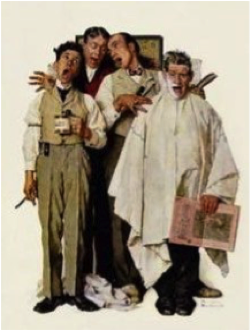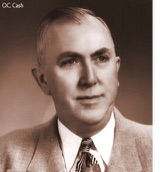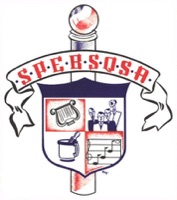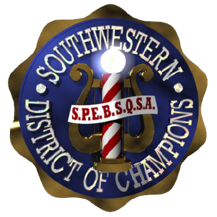Barbershop Harmony

Enter Text
Barbershop harmony is fun, and it is a uniquely American art form. Its songs tell stories, sometimes sweet and sometimes funny but always in four part chords that make a song “ring.” Barbershop quartets and choruses sing a variety of music, from traditional barbershop ballads to 50’s doo-wop and pop, but all rooted in the barbershop tradition.
Barbershop singing did actually begin in barbershops — and on street corners where it was sometimes called "curbstone" harmony, at social functions, and in parlors. But it wasn’t just sung by handlebar-mustached white men in striped vests as depicted in the famous Norman Rockwell painting. Its roots
are much more diverse. A melting pot product of African-American musical devices, the European hymn-singing culture, and an American tradition of recreational music, barbershop harmony dates back to the late 19th century when barbering jobs were often held by gypsies, European immigrants, and African Americans. Barbershops were where men hung out, and Black historian James Weldon Johnson wrote of the era: "Every barbershop seemed to have its own quartet." The first written

The first written reference to "barbershop" harmony came in 1910 with the publication of a song, Play That Barbershop Chord, and barbershop harmony gained wide popularity as Tin Pan Alley songwriters found a ready market for the simple, straightforward melodies and heartfelt, commonplace thems of barbershop songs.
When the phonograph made it possible to actually hear the new songs from Tin Pan Alley, professional quartets recorded hundreds of songs that spurred music sales. Sweet Adeline and similar songs captured the hearts of harmony lovers.
Then came the Jazz era, and American music and social habits began to change. Songwriters turned to more sophisticated melodies for the new professional radio singers, songs that emphasized jazz rhythms better suited for dancing than for harmonizing.
But close harmony singing remained popular with many amateur singers, and those singers were ready for a revival of barbershop harmony by April 1938, when a Tulsa businessman, O.C. Cash, ran into a friend, Rupert Hall, while visiting in Kansas City.
They lamented the decline of an American institution, the barbershop quartet and decided they should do something about it. Cash suggested they gather some like-minded men for a night of singing, and he returned home to send an invitation to friends he thought might be interested. That led to 26 men meeting at a Tulsa hotel's rooftop restaurant a few weeks later. There was no grand plan. Nothing was envisioned for the future. It was just an evening of fun; however, it led to much more.

The men who answered Cash's invitation and had such fun at that evening of singing wanted more, and 150 voices were harmonizing in the hotel’s rooftop garden by the third meeting. It caused such a stir that a traffic jam formed outside the hotel, a local newspaper reporter investigated the cause of the commotion. Cash bluffed his way through an interview, calling the group the "Society for the Preservation and Propagation of Barber Shop Quartet Singing in the United States (SPPBSQSUS)" and saying it had branches in St. Louis, Kansas City, and elsewhere across America. He neglected to say that the "branches" were just a few scattered friends who enjoyed harmonizing - and who knew nothing of his new club. Cash titled himself "Third Temporary Assistant Vice Chairman" of the then-nonexistent organization and said Rupert Hall was "Royal Keeper of the Minor Keys."
Enter Text
O.C. Cash's flair for publicity, combined with the group’s unusual name (ridiculous initials that poked fun at the alphabet soup of New Deal programs), made irresistible fodder for the news wire services, and the story quickly spread coast-to-coast. There was a barrage of calls from men interested in joining, and groups began springing up across North America. That was the birth of the Barbershop Harmony Society, known for many years by its original name: SPEBSQSA (Society for the Preservation and Encouragement of Barbershop Quartet Singing in America). The resurgance of barbershop harmony has not slowed down since.

Today, the Barbershop Harmony Society is the world's largest all-male singing organization, with about 30,000 singers in more than 800 chapters in the United States and Canada. Another 4,000 barbershoppers are members of affiliated organizations in Australia, Germany, Great Britain, The Netherlands, New Zealand, South Africa and Sweden.
The group's Nashville headquarters administers its worldwide activities, preserves the world's largest privately-held collection of sheet music, and is a repository for barbershop memorabilia, early recordings, costumes, research materials and historical documents that trace the roots of the barbershop style.

Around the world, barbershop harmony groups gather to share the fun of singing, present shows for their communities, compete in regional and international quartet and chorus contests, and raise money for a foundation that supports youth music education.
The Centroplex Chapter is part of the Barbershop Harmony Society's five-state Southwestern District and includes men from Waco, Temple, Belton, Killeen, Georgetown, Cameron, Gatesville, and other central Texas communities. Performing as The Texas Country Gentlemen chorus, the chapter meets each Tuesday evening at the Cultural Arts Center in Temple.
The ringing chords of barbershop harmony have captivated singers and listeners for well over a century, and the Texas Country Gentlemen are proud to help the tradition continue.

